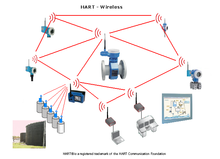Highway Addressable Remote Transducer
Highway Addressable Remote Transducer ( HART ) is a standardized, widely used communication system for setting up industrial fieldbuses . It enables the digital communication of several participants ( field devices ) via a common data bus . HART is based specifically on the 4/20 mA standard (for the transmission of analog sensor signals ), which is also widely used . Existing lines of the older system can be used directly and both systems can be operated in parallel. The HART was developed by Rosemount for their field devices in the 1980s. In 1989 the HART standard was brought into being by the HART Communication Foundation (HCF). HART has been part of the fieldbus standard IEC 61158 since 2007 . The HART Communication Foundation is based in Europe in Basel (Switzerland).
Advantages of HART
- Construction of a digital fieldbus network using (extensive) use of existing 4/20 mA cabling
- Parallel operation of existing, analog 4/20 mA and digital systems
- Bus or network structure: Several HART field devices can communicate bidirectionally and acyclically via a 4/20 mA cable .
Data transfer
The data is transmitted according to the Bell 202 standard using frequency shift keying (FSK). A high-frequency oscillation (+/- 0.5 mA) is superimposed on the low-frequency analog signal. A digital “1” is shown with the frequency 1.2 kHz (1200 Hz) and a “0” is shown with the frequency 2.2 kHz (2200 Hz).
HART specifies several protocol levels in the OSI model and allows the transfer of process and diagnostic information as well as control signals between field devices and the higher-level control system . Standardized parameter sets can be used for cross-manufacturer operation of all HART devices. Most well-known manufacturers of sensors (field devices) offer devices with - in some cases optional - HART communication. Typical applications are transducers for measuring mechanical and electrical quantities.
The communication between the devices can take place according to the master / slave principle, that is, the slave - the field device - only sends information when a request has been made by the master - the control center. Another way of communication is burst mode. After initiating communication, the slave sends unsolicited messages to the master.
WirelessHART
In September 2007, the HCF (HART Communication Foundation) defined and published the new WirelessHART standard. The radio transmission is based on the wireless communication standard IEEE 802.15.4 ( ISM band ) and uses TDMA as the transmission method . The communication provides encryption based on the Advanced Encryption Standard (AES 128) so that the data transfer and the parameterization of the field devices cannot be changed without authorization.
WirelessHART is part of the new HART 7 specification and has been standardized as IEC 62591: 2010. The HART test specification is expected to be completed by mid-2008. The first WirelessHART-compliant measuring devices should therefore still be available in 2008.
Essential properties
The network builds itself up (meshed network). If a field device is to be added to an existing network, a type of password only needs to be entered; the topology structure is self-organizing. Outside, transmission distances of up to 250 m from participant to participant are possible. In the case of participants spatially following one another, significantly larger distances can therefore be bridged, since the intermediate participants act as repeaters, so to speak.
Built-in redundancy: If a participant fails as a transmission path, the transmission is automatically established via another participant. The same information is transmitted as with the wired HART. The measured value transmission cycles depend on the respective system configuration and are typically between 15 seconds and several hours.
Applications
Typical areas of application for WirelessHART:
- large distances to be bridged, such as for tank monitoring
- Measuring devices that are mounted on rotating or moving parts
- in the event of obstacles on the signal path such as train tracks or rivers
- Parameterization and operation of HART components on controls that were previously not HART capable
- subsequent or temporary installation of field devices
- Open and standardized thanks to the support of all HART devices registered with the HCF (HART Communication Foundation).
See also
- WiTECK , an open non-profit organization that offers WirelessHART
- Information transfer
- ZigBee , an open radio network standard also used in industry
Web links
- FieldComm Group
- Technical article The pragmatic use of wireless technologies is gaining the upper hand
- Article WirelessHART - the facts
- .NET open source project for communicating with HART field devices
- An example for using Hart even in Microsoft Excel (PDF; 115 kB)
Individual evidence
- ↑ Wireless HART - today and tomorrow - press information
- ↑ Stefan Kuppinger: WirelessHART in the acid test. Retrieved March 12, 2019 .
- ^ Deji Chen, Mark Nixon, Aloysius Mok: WirelessHART: Real-Time Mesh Network for Industrial Automation . Springer US, 2010, ISBN 978-1-4419-6046-7 ( springer.com [accessed March 12, 2019]).
- ^ Pepperl + Fuchs: Gateways. March 12, 2019, accessed on March 12, 2019 (German).
- ↑ PHOENIX CONTACT: WirelessHART. Retrieved March 12, 2019 .
